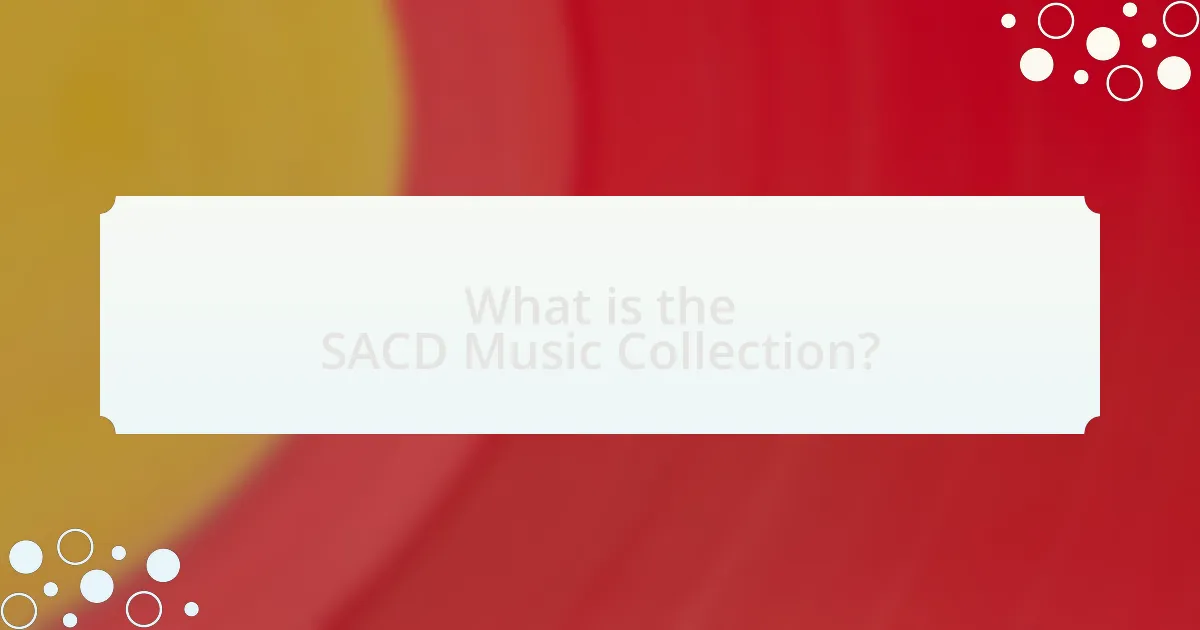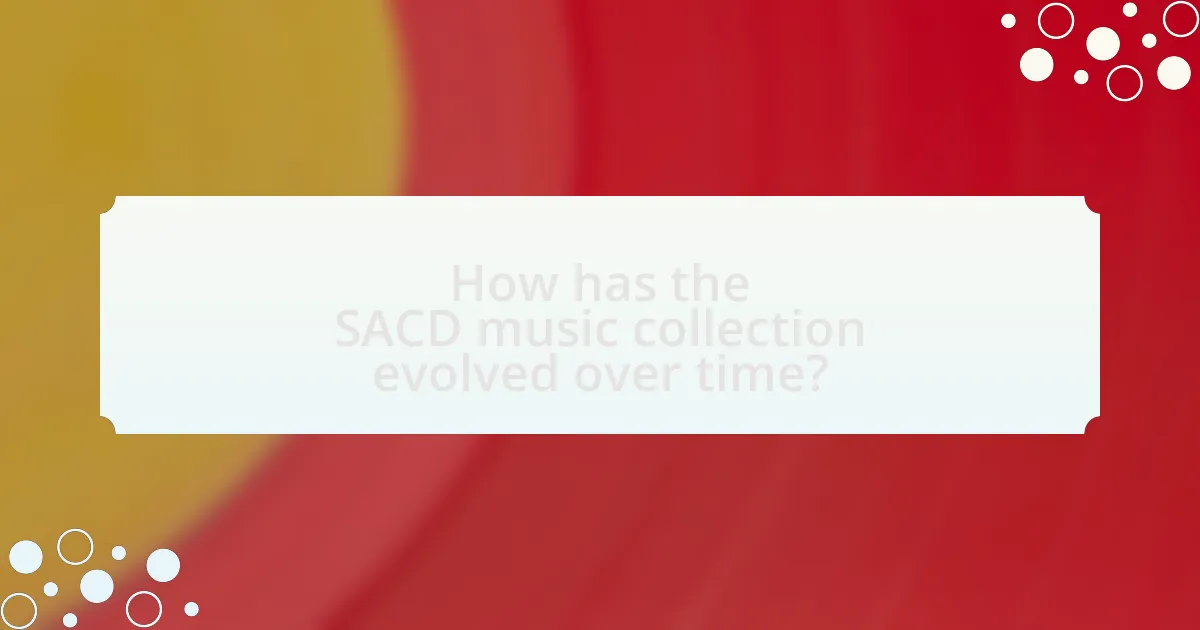The SACD Music Collection refers to a compilation of music recorded in the Super Audio CD format, which delivers high-resolution audio quality through Direct Stream Digital (DSD) technology. Introduced in 1999 by Sony and Philips, SACD was developed to address the limitations of standard CDs, offering multi-channel audio capabilities for an immersive listening experience. The article explores the emergence of SACD, its technological advancements, key features, significance in the music industry, and the challenges it faced. Additionally, it discusses the evolution of SACD collections over time, current trends, and practical tips for enhancing the SACD listening experience.
What is the SACD Music Collection?

The SACD Music Collection is a compilation of music recorded in Super Audio CD format, which offers high-resolution audio quality. This format was developed by Sony and Philips in the early 2000s to provide an enhanced listening experience compared to standard CDs, utilizing a different encoding method known as Direct Stream Digital (DSD). The SACD format supports multi-channel audio, allowing for a more immersive sound experience, and has been adopted by various artists and labels to release albums that showcase superior sound fidelity.
How did the concept of SACD emerge?
The concept of Super Audio CD (SACD) emerged in the late 1990s as a response to the limitations of the standard CD format, particularly in delivering high-resolution audio. Developed by Sony and Philips, SACD aimed to provide a superior listening experience through its ability to support multi-channel audio and higher sampling rates, specifically 2.8 MHz DSD (Direct Stream Digital) technology. This innovation was driven by the growing demand for enhanced audio quality among audiophiles and the music industry’s need to offer a more immersive sound experience. The introduction of SACD in 1999 marked a significant advancement in digital audio formats, positioning it as a competitor to DVD-Audio and appealing to both consumers and music producers seeking higher fidelity sound reproduction.
What technological advancements led to the creation of SACD?
The creation of Super Audio CD (SACD) was primarily driven by advancements in digital audio technology, specifically the development of Direct Stream Digital (DSD) encoding. DSD allows for high-resolution audio reproduction by using a 1-bit delta-sigma modulation technique, which captures audio at a sampling rate significantly higher than that of standard CDs. This technology enables a more accurate representation of sound, resulting in improved audio fidelity. Additionally, the introduction of multi-channel audio formats and advancements in optical disc technology facilitated the SACD’s capability to deliver both stereo and surround sound experiences, further enhancing its appeal to audiophiles.
What are the key features that define SACD music collections?
SACD music collections are defined by their high-resolution audio quality, multi-channel sound capabilities, and hybrid disc format. The high-resolution audio quality allows for a sampling rate of up to 2.8224 MHz, significantly surpassing standard CDs, which enhances the listening experience. Multi-channel sound capabilities enable immersive audio experiences, often featuring 5.1 surround sound, which is particularly appealing for home theater systems. The hybrid disc format includes both a standard CD layer and a high-resolution SACD layer, ensuring compatibility with a wide range of players. These features collectively contribute to the SACD’s reputation for superior sound fidelity and versatility in playback options.
Why is SACD significant in the music industry?
SACD, or Super Audio CD, is significant in the music industry because it offers high-resolution audio quality that surpasses traditional CD formats. Introduced in 1999, SACD utilizes Direct Stream Digital (DSD) technology, which allows for a more accurate representation of sound, providing a richer listening experience. This format supports multi-channel audio, enabling immersive soundscapes that enhance the overall musical experience. The introduction of SACD also marked a shift towards high-fidelity audio formats, influencing the production and distribution of music, as artists and labels began to prioritize sound quality in their releases.
How does SACD differ from other audio formats?
SACD, or Super Audio CD, differs from other audio formats primarily in its ability to deliver high-resolution audio through Direct Stream Digital (DSD) encoding, which provides a more accurate representation of sound compared to traditional PCM formats used in CDs and other digital audio formats. This high-resolution capability allows SACD to reproduce audio frequencies up to 100 kHz, significantly higher than the 20 kHz limit of standard CDs, resulting in a more detailed and immersive listening experience. Additionally, SACDs can support multi-channel audio, enabling surround sound configurations that enhance the overall auditory experience, a feature not universally available in other formats.
What impact has SACD had on music listening experiences?
SACD has significantly enhanced music listening experiences by providing superior audio quality through its high-resolution format. This technology allows for a broader dynamic range and improved sound fidelity compared to standard CDs, enabling listeners to experience music with greater clarity and depth. The introduction of multi-channel audio in SACD also allows for immersive listening experiences, as it can reproduce sound in a surround format, making the listener feel as though they are part of the performance. Studies have shown that listeners often prefer the sound quality of SACD over traditional formats, which has led to a resurgence in interest for high-fidelity audio systems.
What are the historical milestones in the evolution of SACD?

The historical milestones in the evolution of SACD include its introduction in 1999 by Sony and Philips, which marked the beginning of the Super Audio CD format aimed at providing high-resolution audio. In 2000, the first SACD titles were released, showcasing the format’s capabilities. The format gained traction in the early 2000s with the release of hybrid SACDs, allowing compatibility with standard CD players. In 2002, the first SACD player, the Sony SCD-1, was launched, further promoting the format. By 2004, major record labels began to adopt SACD for classical and jazz music, enhancing its reputation. The introduction of multi-channel SACDs in 2005 expanded the listening experience, and by 2010, the format had established a niche market, although it faced competition from digital downloads and streaming services. These milestones illustrate the development and adaptation of SACD in the music industry over the years.
When was SACD first introduced to the market?
SACD, or Super Audio CD, was first introduced to the market in 1999. This format was developed by Sony and Philips to provide high-resolution audio playback, enhancing the listening experience compared to standard CDs. The introduction of SACD marked a significant advancement in audio technology, aiming to deliver superior sound quality through its multi-channel capabilities and higher sampling rates.
What were the initial reactions from consumers and critics?
Initial reactions from consumers and critics regarding SACD music collections were mixed. Many consumers praised the superior sound quality and the immersive listening experience offered by the format, highlighting its ability to deliver high-resolution audio that surpassed traditional CDs. Critics, however, expressed skepticism about the market viability of SACDs, citing limited catalog availability and the higher price point compared to standard CDs as potential barriers to widespread adoption. This duality in feedback reflects both enthusiasm for the technological advancements and concerns over practical accessibility within the music industry.
How did early SACD releases shape its popularity?
Early SACD releases significantly shaped its popularity by offering superior sound quality and a unique multi-channel audio experience. The introduction of titles from renowned artists and labels, such as the initial releases by Sony and Philips in 1999, showcased the format’s capabilities, attracting audiophiles and music enthusiasts. Additionally, the inclusion of hybrid discs allowed compatibility with standard CD players, broadening the potential audience. This strategic approach, combined with the marketing of SACD as a premium audio format, contributed to its initial acceptance and growth in the market.
What challenges did SACD face in its development?
SACD faced several challenges in its development, primarily related to market acceptance, technological limitations, and competition. Market acceptance was hindered by consumer reluctance to adopt a new format, as many were satisfied with existing CD technology. Technological limitations included the high cost of production and the complexity of the SACD player, which deterred manufacturers and consumers alike. Additionally, competition from other high-resolution audio formats, such as DVD-Audio, further complicated SACD’s market position. These factors collectively impacted SACD’s ability to gain widespread traction in the music industry.
What were the main obstacles to widespread adoption of SACD?
The main obstacles to widespread adoption of SACD included high production costs, limited hardware availability, and a lack of consumer awareness. High production costs made it economically challenging for record labels to produce SACD titles, leading to a limited catalog. Limited hardware availability restricted consumer access, as many players were expensive and not widely distributed. Additionally, a lack of consumer awareness about the benefits of SACD over existing formats like CD hindered its market penetration, resulting in lower demand and fewer releases.
How did competition from other formats affect SACD’s evolution?
Competition from other formats, particularly DVD-Audio and digital downloads, significantly impacted SACD’s evolution by limiting its market share and adoption. The introduction of DVD-Audio in 2000 offered similar high-resolution audio capabilities, which diverted consumer interest away from SACD. Additionally, the rise of digital downloads and streaming services provided more convenient and accessible alternatives for music consumption, further diminishing SACD’s appeal. As a result, SACD struggled to establish a strong foothold in the market, leading to reduced production and support from record labels, ultimately hindering its growth and longevity in the music industry.
How has the SACD music collection evolved over time?

The SACD music collection has evolved significantly since its introduction in 1999. Initially designed to provide high-resolution audio, SACD collections began with a limited selection of classical and jazz titles, appealing primarily to audiophiles. Over time, the catalog expanded to include a broader range of genres, including pop and rock, as major record labels recognized the format’s potential for enhanced sound quality. By the mid-2000s, the introduction of hybrid SACDs, which contain both SACD and standard CD layers, further increased accessibility and consumer adoption. As of 2023, the SACD collection continues to grow, with ongoing releases and reissues of classic albums, demonstrating its enduring appeal in the high-fidelity audio market.
What changes have occurred in SACD technology?
SACD technology has evolved significantly since its introduction in 1999, primarily through advancements in audio quality, format compatibility, and production techniques. Initially designed to provide high-resolution audio, SACD has seen improvements in DSD (Direct Stream Digital) encoding, which enhances sound fidelity and dynamic range. Additionally, the integration of hybrid SACDs, which contain both SACD and standard CD layers, has increased accessibility for consumers. The development of better mastering techniques and the use of advanced digital processing have also contributed to the overall enhancement of SACD sound quality. These changes reflect the ongoing efforts to adapt to consumer preferences and technological advancements in the audio industry.
How have advancements in digital audio influenced SACD?
Advancements in digital audio have significantly influenced SACD by enhancing its sound quality and playback capabilities. The introduction of higher sampling rates and bit depths in digital audio technology has allowed SACD to deliver a more accurate and detailed sound reproduction compared to traditional CD formats. For instance, SACD utilizes Direct Stream Digital (DSD) encoding, which operates at a 2.8 MHz sampling rate, providing a broader frequency response and improved dynamic range. This technological evolution has made SACD a preferred choice for audiophiles seeking superior audio fidelity, as evidenced by its adoption in high-end audio systems and the growing catalog of SACD releases that leverage these advancements.
What role has consumer demand played in SACD’s evolution?
Consumer demand has significantly influenced the evolution of SACD (Super Audio CD) by driving manufacturers to enhance audio quality and expand product offerings. Initially introduced in 1999, SACD aimed to provide superior sound quality compared to standard CDs, but its adoption was heavily reliant on consumer interest in high-fidelity audio formats. As audiophiles and music enthusiasts expressed a desire for better sound experiences, manufacturers responded by producing more SACD players and a wider selection of SACD titles. This shift is evidenced by the fact that, by 2003, over 1,000 SACD titles were available, reflecting the growing consumer base and demand for high-resolution audio. Thus, consumer preferences have been a critical factor in shaping the development and market presence of SACD.
What are the current trends in SACD music collections?
Current trends in SACD music collections include a resurgence in interest due to the growing demand for high-resolution audio formats and the increasing availability of classic and contemporary titles. This trend is supported by the rise of audiophile communities and the expansion of SACD catalogs from major labels, which now frequently release remastered versions of popular albums. Additionally, the integration of SACD playback capabilities in modern audio equipment has made these collections more accessible to consumers, further driving their popularity.
How are modern artists utilizing SACD for their releases?
Modern artists are utilizing SACD (Super Audio CD) for their releases to enhance audio quality and provide a superior listening experience. By leveraging the high-resolution audio capabilities of SACD, artists can deliver richer soundscapes and greater dynamic range, appealing to audiophiles and music enthusiasts. For instance, many contemporary musicians and labels are producing hybrid SACDs, which contain both high-resolution audio and standard CD layers, allowing broader accessibility while maintaining high fidelity. This approach not only caters to traditional collectors but also attracts new listeners who value sound quality.
What genres of music are most commonly found in SACD format today?
The most commonly found genres of music in SACD format today are classical, jazz, and rock. Classical music dominates the SACD market due to its high fidelity requirements, with many orchestral and chamber works being released in this format. Jazz also thrives in SACD, as audiophiles appreciate the enhanced sound quality for intricate performances. Rock music, particularly from iconic bands and albums, has seen a resurgence in SACD releases, appealing to collectors and enthusiasts who seek superior audio experiences.
What is the future of SACD music collections?
The future of SACD music collections appears to be limited due to the rise of digital streaming and high-resolution audio formats. As consumer preferences shift towards more accessible and convenient music consumption methods, the demand for physical formats like SACD is declining. According to a report by the Recording Industry Association of America, physical music sales have been decreasing annually, with digital formats dominating the market. This trend suggests that while SACD may maintain a niche audience among audiophiles, its overall relevance in the broader music landscape is diminishing.
How might emerging technologies impact SACD’s relevance?
Emerging technologies may diminish SACD’s relevance by providing alternative high-resolution audio formats that are more accessible and user-friendly. For instance, advancements in streaming technology and the rise of lossless audio formats like FLAC and MQA allow consumers to enjoy high-quality sound without the need for physical media. According to a 2021 report by the International Federation of the Phonographic Industry, streaming accounted for 62% of global recorded music revenue, indicating a significant shift in consumer preferences towards digital formats. This trend suggests that as digital audio technology continues to evolve, SACD may struggle to compete in a market increasingly dominated by streaming services and downloadable content.
What predictions can be made about the growth of SACD collections?
Predictions about the growth of SACD collections indicate a gradual increase in popularity, driven by the resurgence of interest in high-fidelity audio formats. The market for SACDs has seen a modest revival, with sales figures reflecting a niche but dedicated consumer base. For instance, the global market for high-resolution audio formats, including SACDs, is projected to grow at a compound annual growth rate (CAGR) of approximately 5% from 2021 to 2026, according to industry reports. This growth is supported by the increasing availability of high-quality recordings and the expansion of audiophile communities that value superior sound quality.
What practical tips can enhance the SACD listening experience?
To enhance the SACD listening experience, use high-quality audio equipment, including a dedicated SACD player and premium speakers. High-quality equipment ensures that the superior audio resolution of SACDs is fully realized, as SACDs can deliver up to six times the audio quality of standard CDs. Additionally, ensure that the listening environment is acoustically treated to minimize sound reflections and external noise, which can detract from the listening experience. Proper speaker placement and the use of high-fidelity cables can further improve sound clarity and depth.
How can listeners optimize their equipment for SACD playback?
Listeners can optimize their equipment for SACD playback by ensuring they use a compatible SACD player that supports both SACD and CD formats. This is crucial because SACD utilizes a different format (DSD) than standard CDs, requiring specific hardware to decode the high-resolution audio properly. Additionally, listeners should connect their SACD player to a high-quality audio system, preferably using HDMI or analog outputs, to preserve audio fidelity. Using high-quality cables can further enhance the signal integrity. Finally, listeners should consider room acoustics and speaker placement to maximize the listening experience, as these factors significantly influence sound quality.
What are the best practices for collecting and maintaining SACD music collections?
The best practices for collecting and maintaining SACD music collections include proper storage, regular cleaning, and careful handling of discs. Storing SACDs vertically in a cool, dry environment prevents warping and scratches, while using protective sleeves can further safeguard the discs. Regularly cleaning the discs with a soft, lint-free cloth helps maintain sound quality and prevents playback issues. Additionally, handling discs by the edges minimizes the risk of fingerprints and smudges, which can affect audio performance. These practices are essential for preserving the integrity and longevity of SACD collections, ensuring optimal listening experiences.

Leave a Reply